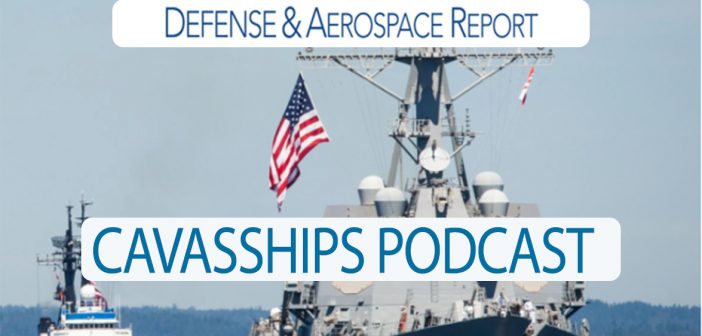Welcome to the CavasShips Podcast with Christopher P. Cavas and Chris Servello…a weekly podcast looking at naval and maritime events and issues of the day – in the US, across the seas and around the world. This week…Damage to the US Navy’s fleet oiler supporting the Abraham Lincoln Carrier strike group in US Central Command has focused attention on the Military Sealift Command’s ability to meet the fleet’s needs. Maritime shipping experts Sal Mercogliano and John Konrad are back with us for a deep dive.
Please send us feedback by DM’ing @CavasShips or @CSSProvision or you can email chriscavas@gmail.com or cservello@defaeroreport.com.
This Week’s Naval News:
A US Navy official confirmed that the Houthi terrorist group in Yemen attacked three US Navy warships during the night of September 25 to 26 as the ships were passing through the Bab Al-Mandab Strait into the southern Red Sea. The attacks, reportedly by a mix of ballistic and cruise missiles and aerial unmanned aircraft, were defeated by the destroyers STOCKDALE and SPRUANCE and the littoral combat ship INDIANAPOLIS, with most of the weapons being intercepted and all failing to inflict any damage on the ships. It was the largest attack in several weeks and broke a period of relative low-level activity in the Red Sea and Gulf of Oman.
In a significant development, the Japanese destroyer SAZANAMI transited the Taiwan Strait on September 25, the first-ever passage of a Japanese Maritime Self-Defense Force ship through the strait between Taiwan and the Chinese mainland. Japanese prime minister Fumio Kishida reportedly ordered the move after numerous passages of Chinese warships and aircraft close to Japan’s home islands. The SAZANAMI was accompanied by the Australian destroyer SYDNEY and New Zealand’s support ship AOTEAROA, the first time Australian and New Zealand ships made the strait transit together. At least five Chinese Navy ships reportedly tailed the Japanese, Australian and New Zealander ships. The move follows the passage down the strait on September 17 by a US Navy P-8A Poseidon aircraft, and of two German naval ships on September 13. Meanwhile, the Italian carrier CAVOUR continued to operate in the western Pacific and departed Singapore September 23rd accompanied by the frigate APLINO and French frigate BRETAGNE.
A new Type 041 nuclear-powered submarine of the Chinese Navy appears to have sunk at a pier last June, the Wall Street Journal and other media outlets are reporting. The 4,000-ton submarine, first of a new class, appears to have sunk while being completed at a shipyard in Wuhan. China has not publicly announced the incident, which seems to have been caught on satellite images.
The aircraft carrier USS HARRY S TRUMAN left Norfolk, Virginia September 23rd to begin a deployment with Carrier Air Wing One embarked. With the Truman Carrier Strike Group are the destroyers STOUT and JASON DUNHAM, with the cruiser GETTYSBURG. The TRUMAN is expected to take up station in US Central Command’s middle east operating area and relieve the USS ABRAHAM LINCOLN. Notably, it’s the GETTYSBURG’s first scheduled deployment in more than a decade. Since returning from her last deployment in April 2014 – coincidentally also with the TRUMAN – GETTYSBURG was largely out of service and was one of seven cruisers inducted into the Navy’s Cruiser Phased Modernization Plan. Of the seven, two upgrades were canceled outright, two more were canceled after several hundred million dollars were spent on the ships, and three more underwent upgrades. Of the three, GETTYSBURG is the first to complete the modernizations and return to operational service. On the west coast, the cruiser CHOSIN returned to San Diego in February but has yet to be declared operational, while work continues on the cruiser CAPE ST. GEORGE.
In the Pacific, the carrier THEODORE ROOSEVELT left Guam September 26th, en route to her homeport at San Diego to conclude an extended deployment to the western Pacific and US Central Command.
The US Navy’s fleet oiler USNS BIG HORN was damaged on September 23rd while operating in the Arabian Sea off the coast of Oman. While no injuries are reported, the ship apparently took on water with flooding in the machinery spaces and suffered damage to a rudder. The BIG HORN was towed to Duqm, Oman, arriving on September 24, and is expected to be repaired at Jebel Ali near Dubai in the United Arab Emirates. The BIG HORN was supporting the ABRAHAM LINCOLN Carrier Strike Group in US Central Command,
The destroyer USS PREBLE left San Diego September 22 to shift homeport to Yokosuka, Japan, where she will replace USS BENFOLD with Forward-Deployed Naval Forces Japan. After nine years based in Japan, BENFOLD left Yokosuka on September 23rd to return to the U.S. and shift homeport to Everett, Washington.
Reports that faulty welds may have knowingly been made to US Navy submarines and aircraft carriers under construction at HII Newport News in Virginia began to circulate in the media the week of September 25th. A Department of Justice investigation is reportedly underway and while details are still thin, the House Armed Services Committee, in a strongly bipartisan effort, on September 27th, announced it too has begun an investigation.
In new ship news, the US Navy on September 24th awarded HII Ingalls Shipbuilding nearly $9.5 billion in contracts to build four amphibious ships – three San Antonio Flight II-class amphibious transport dock ships- LPDs 33, 34 and 35 – and the big-deck assault ship HELMAND PROVINCE LHA 10. The contracts, whose awards were signaled a month ago by the Navy, effectively end the so-called amphibious ship “pause” of a year ago to review requirements for both the Navy and the Marine Corps. Ingalls is the only shipyard currently building both types of ship.
The fleet replenishment oiler LUCY STONE, T-AO 209, was christened and launched September 23 at General Dynamics NASSCO shipyard in San Diego. The LUCY STONE is the fifth new ship of the JOHN LEWIS class, of which the Navy plans to purchase a total of 20. On September 13, the Navy awarded NASSCO a construction contract for eight ships of the class, T-AOs 214 through 221, leaving three more to be awarded at a future date.
And in old ship news, two more Ticonderoga-class cruisers have been decommissioned. The USS LEYTE GULF held a decommissioning ceremony September 20th at Norfolk, and USS ANTIETAM held her ceremony September 27 at Pearl Harbor. Both ships had been commissioned in 1987 and each served for about 37 years. Only nine of the original 27 ships in the class remain in commission.



![DEFAERO Daily Pod [Oct 14, 25] Lockheed Martin’s Dan Tenney](https://defaeroreport.com/wp-content/uploads/2025/10/Screenshot-2025-10-14-at-8.20.55-AM-214x140.png)
